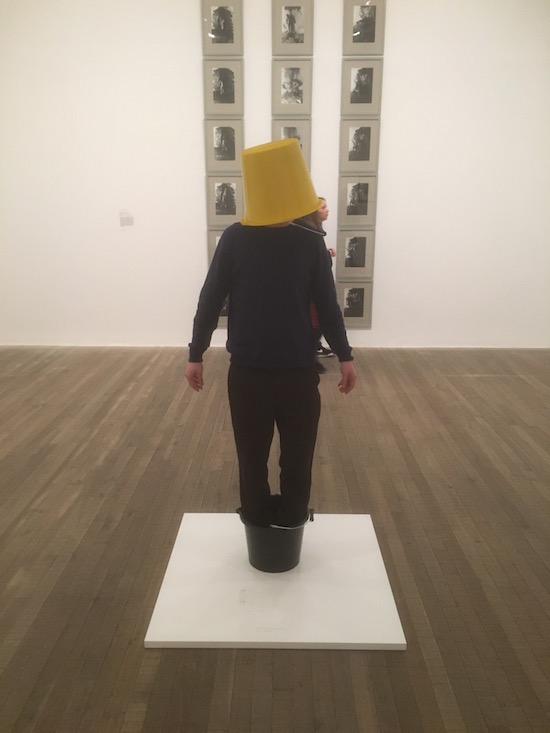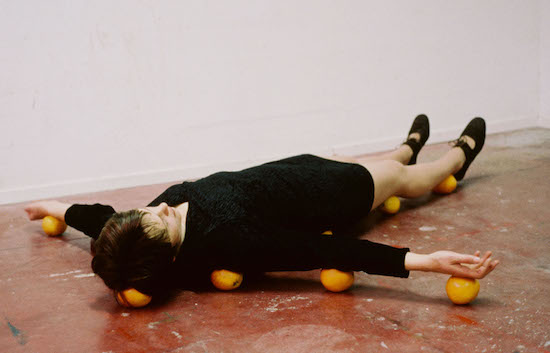It is a curious feeling to find oneself transformed, even if only for a short while, into a work of art. Ever more so, to become a work of art by someone else. But on Monday night that is exactly what happened to me. I stood on a small white plinth in one of the galleries on the Tate Modern’s third floor, placed both feet in a black plastic bucket, with another bucket, a yellow one, over my head. There I was: a One Minute Sculpture by Erwin Wurm. Can I step down now, please?
The thing is, the black bucket being a little bit too small for my leather-soled size nines, this was as much a balancing act as a profound gesture of aesthetic embodiment. My knees quivered in suspense, waiting for my sixty seconds to elapse, hoping desperately that I wouldn’t topple over. Did I feel more like Michelangelo’s David or Charlie Chaplin’s tramp? I’m not sure. Probably somewhere in between the two. Such is the curious liminal space Wurm operates in, at once comic and sublime.
My anxiety didn’t stop there. Removing one bucket from my head, stepping free of the other and off the plinth, the thought struck me: at what point, precisely, will I cease to be a sculpture? Might there still remain some small statuesque residue even as I leave the gallery and take the train home? Is there some ambiguous point where I am transitioning between sculpturehood and non-sculpturehood?
“This was from the very beginning a big interest, from my side,” Wurm confirms to me over the telephone the next day when I call him, still a little panic-stricken at the thought of possible after-effects wrought by this modern medusa. “I asked myself, when somebody is standing quiet,” Wurm goes on, “or when I am standing quiet, is this an action? Or can it be possible that it moves slowly into what I can call sculpture?”
There was a pause. Dead air on the line. I am standing pretty quiet right now, on the phone. Well, sitting, but still. Was I inadvertently becoming sculpture again? A bead of sweat forms on my brow. Was my ankle getting stiff? “But I think you are only a sculpture when you follow the instructions and you stand quiet for, let’s say, thirty seconds or two minutes.” Phew! My limbs grew supple with relief.
“I think there is a kind of cut out of time and space,” Wurm continues, clearly warming to his theme now, “which, all of a sudden, the piece works and it transfers it – if you are willing to agree to accept it. Art always relies on the will of the spectator.”
But what if it were to happen accidentally? I had to be sure. Say, someone was walking along the street, past a building having its windows cleaned. Not paying attention as they walk, they step into a bucket left carelessly unsignposted on the pavement and at that very moment a second bucket falls from the third floor and lands on their head.
“That’s called slapstick!” Wurm admonishes. “I’m not a humorist. I was always trying to think what a sculpture could be nowadays, when everything is so short-lived and is constantly changing. I wanted to create something with a – let’s say, with a quality and an energy, but that exists only for a very short period of time. I’m still dreaming that this is maybe possible. It’s more about my wish and my ideas.”

The author having become a One Minute Sculpture
Erwin Wurm was born in Austria, in 1954, in the small Styrian town of Bruck an der Mur, a city famous for its annual Murenschalk festival during which clowns take over the streets and public squares, performing acrobatic feats and harassing passers-by. He once claimed he came to sculpture “by chance”. Over the years, he has made cars look sort of fat and suburban houses very, very thin. The series of One Minute Sculptures began in 1997 at the Bremen Künstlerhaus.
“I got an invitation for a show in Bremen,” he explains, “and I thought this could be a good opportunity to try what I had wanted to do for a couple of years, but I’d never had time. So I drove there without sending anything, and went there ten days in advance, and started to try these things out.” He had the gallery’s director stick magic markers up his nose and a stapler in his mouth, empty plastic film canisters bunged up his eye sockets and a pen in each ear, looking for all the world like some madman’s impression of Godzilla.
The idea, he tells me, grew from a realisation that “the existence time of sculpture had become less and less important. There were all these works,” he explains, “with sweaters, clothes, dust, and all these things. So the pieces, in a way, existed only for a short period of time: a month, six weeks, two weeks. An exhibition period. It became shorter and shorter. The action became more and more important. So at a certain point, I decided that I would like to give this short-lived sculpture a specific name.”
“The idea,” he continues, “was to connect daily life with art. I wanted to make these funny, strange, ridiculous, embarrassing, short-living sculptures.”
At the Tate Modern there were four different One Minute Sculptures, with an open invitation to the public to try them out. People posed with broom heads and detergent bottles on their heads or philosophy books wedged between their legs and arms (“good for toning the butt, this one” I heard a volunteer declare, crouching awkwardly with a volume of Sartre between her knees.
“It feels rather precarious,” another volunteer said, a carton of milk poised on each foot. “It’s an indictment of the precarity of modern life!” This one looks easy, I thought. So I stepped up myself when he was done and positioned a tetrapak per toecap. Before long, I started to feel peculiar. Can I get down now? “No, no!” a gallery assistant demanded. “You have to stay – and contemplate!”
“I have realised at that time that everything is possible,” Wurm told me the following day. “Everything that I try to transfer into the art is possible. So I was very much interested in working with very low, low, low materials which nobody finds so interesting to the art world.” He doesn’t even chose them himself, he admits. “I always ask the curator to go and buy these things, so they are not related to my personal taste. I wanted to keep this taste question out.”
One thing that is important, though, is that they don’t lapse into historical fetish. “They should look really normal,” Wurm insists. “It should be the most simple and normal prop you can get. That’s a specific problem. Remember Marcel Duchamp, when he made his bottle dryer [Egouttoir, 1914] or his shovel [En prévision du bras cassé, 1915]. Those are curious objects from the 1920s now, but he meant to use a simple object. To get rid of this, I made contracts with the museums that bought the pieces that they had to throw the props away after a certain number of years and buy new stuff.”
At the Tate Modern, it was evident that a peculiarly fortuitous historical convergence had taken place. As people fell over themselves (in some cases, literally) to maintain their poses with this oddly domestic objects fudged about their person while simultaneously holding out their mobile phones to document their newfound status as living art object, it was clear that the meeting of One Minute Sculpture and self-shot camera-phone snap was a marriage made in heaven. “Absolutely right!” Wurm says, “but remember, when I started to do these things, selfies didn’t exist. At that time, we used polaroids.”
“When we did the show at the Museum of Modern Art in New York, I asked the institution to organise a polaroid camera. The public could buy for, I don’t know, a dollar, a polaroid picture, and the guard would make the picture. Then they could either take it home or they could send me the polaroid with a hundred dollars and I would sign it and send it back as an original by myself. I was also playing with authorship! The people then took the piece and then tried to sell it on eBay, so I stopped it! I thought it would be a great business idea, but it was not at all.”
And what about when people change the poses in some way? I noticed at the Tate, some people couldn’t quite follow the instructions correctly, so they would adapt them, making their own sculptures, in a way. I was curious how Wurm would feel about that.
“I am very strict with the pieces,” he says. “I think that’s one of the reasons why they still exist after twenty years of doing them. It’s a piece only when they really follow my instructions, of me, of Erwin Wurm! If they do something else, it’s ok! But it’s another story, it’s another thing. I don’t care. They can do what they want. But if they want to do a piece of mine, they have to follow.”
Erwin Wurm’s One Minute Sculptures are on display as part of Performing For The Camera at Tate Modern until 12 June


